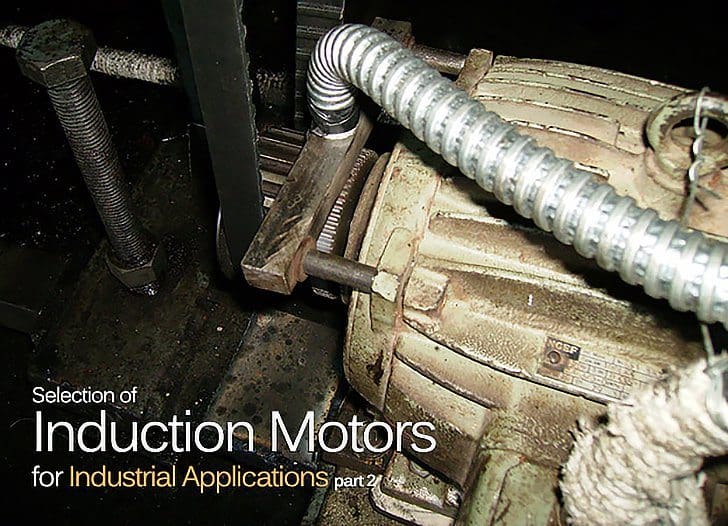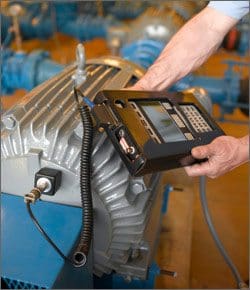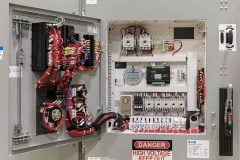
Continued from first part: Selection of Induction Motors for Industrial Applications (part 1)
Design Considerations (cont.)
Motor Efficiency

Though standard motors are now available with a better efficiency, this factor (motor efficency) requires due attention when making the selection of the motor for a specific application in view of substantial quantum of power consumed by the motors in the industries.
The motors running continuously should be as efficient as possible to reduce the power consumption.
For the drives to be in service round the clock, due consideration should be given install the energy efficient motors having EFF 1 or EFF 2 class even at the higher cost, as the premium paid in the form of capital investment will be paid backhand somely in the form of cost saving due to significant energy saving when the drive will be kept in continuous service.
Ambient Temperature
As per normal standards, the motor output is given by the vendors based on 40°C ambient temperature.
If ambient temperature is expected to be high for a longer duration, then the motor is required to be checked for its suitability to maintain the specified output at higher temperature, or otherwise, the deration factor is to be applied to know the actual anticipated output at higher temperature.
In order to maintain the motor output at higher temperature as per the power requirement of driven equipment, it may be necessary that the motor with a higher frame size for the same rating is selected to avoid adverse effect of derating.
Altitude
The standard motor outputs are specified by the manufacturers for site altitude up to 1000 m.
For altitudes of more than 1000 m, the motor ratingis required to be checked for its suitability to maintain the specified output, or otherwise the duration factor is to be applied to know actual anticipated output at higher altitude. Criteria for the selection of motor remains the same as provided for higher ambient temperature.
Method of Starting and Number of Starts

The starting performance of the motor depends on the method of starting deployed, i.e. directon-line, star-delta, high resistance, auto transformer, variable frequency drive, etc.
The direct-on-line starting (DOL motor starter) is the most common method adopted in which the starting current is 6-7 times the rated full load current of the motor. For high starting torque, the direct-on-line starting is essential. If the motor driving a load requiring high starting torque is started using star-delta starting, either the speed may not pick-up affecting the motor acceleration, or may take a very long time to come up to its rated speed under loaded condition inducing severe electrical and mechanical stresses respectively in the winding and core.
Where the starting torque requirement is not so critical, the star-delta starting or any other reduced voltage method of starting is used.
Where the starting with very heavy load, such as with hoist or crane drives, and speed control over a wide range is required, it is advantageous to consider the slip-ring type (or wound rotor type) motor with a drum controller starter or resistance starter.
It is essential to specify anticipated number of starts per hour or per shift of 8-hrs duration as well as number of consecutive starts required when the motor is started from cold or hot condition for facilitating the design of motor windings and selection of correct class of insulation to encounter anticipated temperature rise due to number of starts.
Large rated motors are often started via soft starters. It is desirable to explicitly specify this requirement so that the motor, compatible for such application, is designed and manufactured.
Duty Cycle

Selecting the proper electric motor also depends on whether the load is steady, variable over a fixed time duration, following a repetitive cycle of variation, or load with pulsating torque or shocks. The motors to be kept min service round the clock, such as driving pumps, fans, etc., may be selected on the basis of continuous load and other factors discussed in this article.
This is the Duty Cycle required to be performed by the motor.
The motors driving the equipment like automatically controlled compressors, cranes, hoists start and stop a number of times per hour and those in some machine tools start and stop many times per minute.
The Duty Cycle is a fixed repetitive load pattern over a given period of time which is expressed as the ratio of on-time to cycle period. When operating cycle is such that electric motors operate at idle or a reduced load for more than 25% of the time, Duty Cycle becomes a factor in sizing electric motors. Also, energy required to start electric motors (that is, accelerating the inertia of the electric motor as well as the driven load) is much higher than for steady-state operation, so frequent starting could overheat the electric motor.
When the motor is supposed to operated at idle or reduced load for more than 25% of the time in accordance with its operating cycle, the Duty Cycle becomes a vital factor in sizing the motor.
Also, the energy required to start the motors, i.e. during accelerating along with driven load, is much higher than that required for steady-state operation, so frequent starting, in most probability, is likely to overheat the motor.
Insulation Class
The permissible temperature rise for six insulation classes is based on the ambient temperature of 40°C as shown in following table for different class of insulating materials.
| Thermal Class of Insulation | Normal permissible temp. rise over 40°C | Normal total temp. °C | Maximum permissible temp. rise °C | Insulating materials |
| A | 60 | 100 | 105 | Cotton, Silk, Impregnated/Coated paper |
| E | 75 | 115 | 120 | Synthetic enamel based on polyvinyl acetate, Polyurethane, Epoxy on polyamide resin |
| B | 80 | 120 | 130 | Mica, Glass fibre, Asbestos with suitable bond, viz. Synthetic resin varnishes, Epoxy resin shellac, Asphalt or bituminous compounds |
| F | 100 | 140 | 155 | Mica, Glass fibre, Asbestos with suitable bond, viz. Alkyd epoxy resin, add silicon alkyd resin |
| H | 125 | 165 | 180 | Silicon elastomers, Mica, Glass fibre, etc. with bonding substances like silicon resins |
| G | 170 | 210 | 225 | Mica porcelain, Other mica class quartz, with bonding materials of silicon resin |
It may be remembered that for every 10°C rise in operating temperature, the insulation life reduces by 50% of its usual life.
Thus the temperature rise in motor is usually the dominating ageing factor of influence on the winding insulating materials and insulation systems. Hence it is essential to specify proper class of insulation for the motor based on design ambient temperature, if it is more than standard design temperature of 40°C.
The endurance of the insulation is adversely affected by many other ageing factors, such as surroundings, electrical and mechanical stresses, vibration, deleterious atmospheres and chemicals, moisture, dirt and radiation.
Will be continued very soon…











Thank you Sir
Thanks, it is so useful